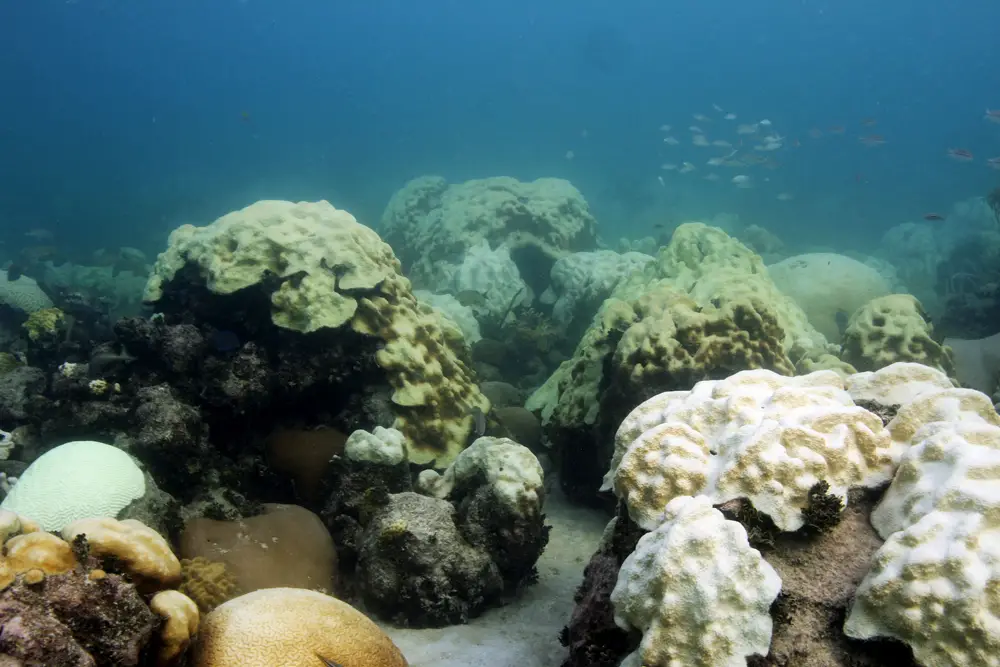
By Ian Enochs
The water off South Florida is over 90 degrees Fahrenheit (32 Celsius) in mid-July, and scientists are already seeing signs of coral bleaching off Central and South America. Particularly concerning is how early in the summer we are seeing these high ocean temperatures. If the extreme heat persists, it could have dire consequences for coral reefs.
Just like humans, corals can handle some degree of stress, but the longer it lasts, the more harm it can do. Corals can’t move to cooler areas when water temperatures rise to dangerous levels. They are stuck in it. For those that are particularly sensitive to temperature stress, that can be devastating.
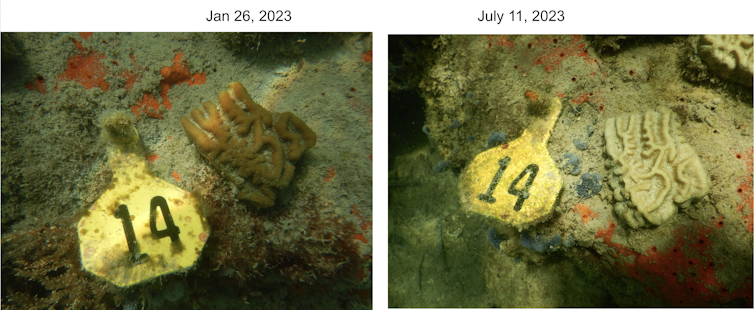
NOAA/University of Miami
I lead the Coral Program at the National Oceanic and Atmospheric Administration’s Atlantic Oceanographic and Meteorological Lab in Miami, Florida. Healthy coral reef ecosystems are important for humans in numerous ways. Unfortunately, marine heat waves are becoming more common and more extreme, with potentially devastating consequences for reefs around the world that are already in a fragile state.
Why coral reefs matter to everyone
Coral reefs are hot spots of biodiversity. They are often referred to as the rainforests of the sea because they are home to the highest concentrations of species in the ocean.
Healthy reefs are vibrant ecosystems that support fish and fisheries, which in turn support economies and food for millions of people. Additionally, they provide billions of dollars in economic activity every year through tourism, particularly in places like the Florida Keys, where people go to scuba dive, snorkel, fish and experience the natural beauty of coral reefs.
If that isn’t enough, reefs also protect shorelines, beaches and billions of dollars in coastal infrastructure by buffering wave energy, particularly during storms and hurricanes.
But corals are quite sensitive to warming water. They host a microscopic symbiotic algae called zooxanthella that photosynthesizes just like plants, providing food to the coral. When the surrounding waters get too warm for too long, the zooxanthellae leave the coral, and the coral can turn pale or white – a process known as bleaching.
If corals stay bleached, they can become energetically compromised and ultimately die.
When corals die or their growth slows, these beautiful, complex reef habitats start disappearing and can eventually erode to sand. A recent paper by John Morris, a scientist in my lab in Florida, shows that around 70% of reefs are now net erosional in the Florida Keys, meaning they are losing more habitat than they build.
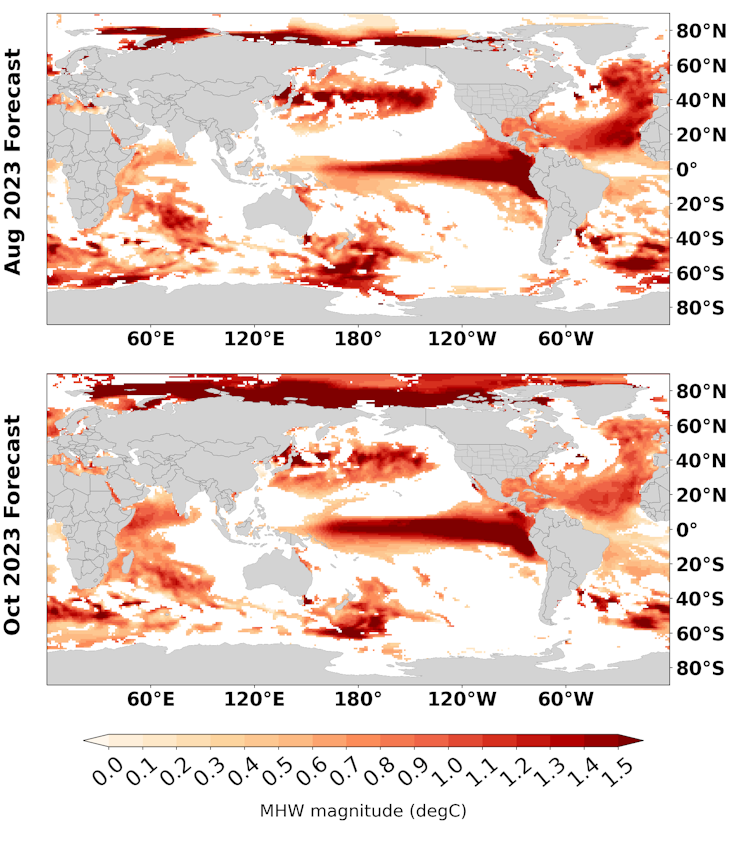
NOAA PSL
Unfortunately, these critical coral reef habitats are in decline around the world because of extreme bleaching events, disease and numerous other human-caused stressors. In the Florida Keys, coral cover has decline by about 90% over the past several decades.
Coral bleaching in 2023
In the Port of Miami, where we have found particularly resilient coral communities, a doctoral candidate in my lab, Allyson DeMerlis, documented the first coral bleaching of her experimentally outplanted corals on July 11, 2023.
Other scientists we work with have reported coral bleaching off of Colombia, El Salvador, Costa Rica and Mexico in the eastern Pacific, as well as along the Caribbean coasts of Panama, Mexico and Belize.
We have yet to see widespread coral death associated with this particular marine heat wave, so it is possible the corals could recover if sea surface temperatures cool down soon. However, global sea surface temperatures are at record highs, and large parts of the Atlantic and eastern Pacific are under bleaching alerts. At this point, the evidence points to the potential for a very negative outcome.
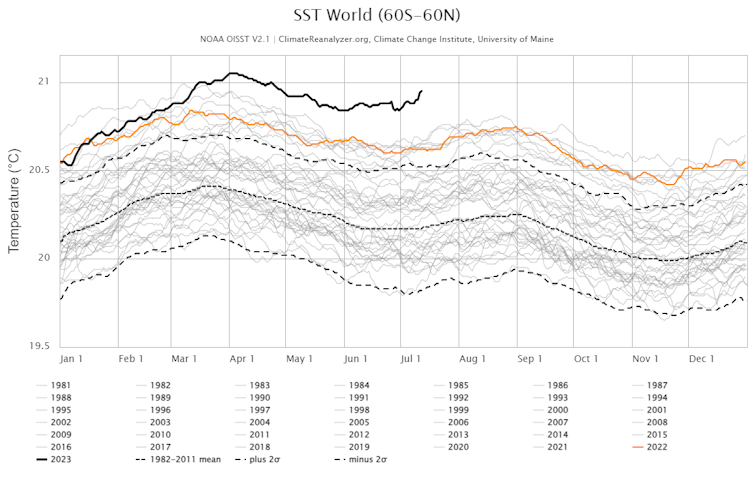
ClimateReanalyzer.org/NOAA OISST v2.1
El Niño is contributing to the problem this year, but the longer-term trends of rising ocean heat are driven by global warming fueled by human activities.
To put that into context, a paper by NOAA scientist Derek Manzello showed that in the Florida Keys, the number of days per year in which water temperatures were higher than 90 F (32 C) had increased by more than 2,500% in the two decades following the mid-1990s relative to the prior 20 years. That is a remarkable increase in the number of days that corals are experiencing particularly stressful warm water.
What can we do to protect corals?
First, we cannot give up on corals.
Alice Webb, a coral reef scientist working with our group, recently published a study based on years of our research in the Florida Keys. She modeled reef habitat persistence under climate, restoration and adaptation scenarios and found that protecting reefs is going to take everything – active restoration of reefs, helping corals acclimate or adapt to changing temperatures, and, importantly, human curbing of greenhouse gas emissions.
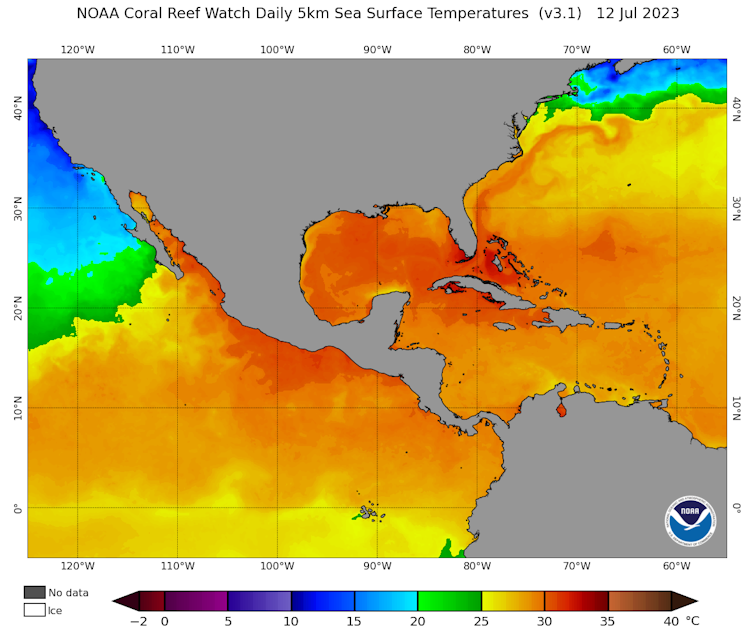
Coral Reef Watch/NOAA
Major restoration efforts are underway in the Florida Keys as part of the NOAA-led Mission Iconic Reefs. We are also assessing how different coral individuals perform under stress, hoping to identify those that are particularly stress-tolerant by combing through the massive amounts of data from restoration projects and coral nurseries.
We are also evaluating stress-hardening techniques. For example, in tide pools, corals are exposed to large swings in temperature over short periods, making them more resilient to subsequent thermal stress events. We are exploring whether it’s possible to replicate that natural process in the lab, before corals are planted onto reefs, to better prepare them for stressful summers in the wild.
Coral bleaching on a large scale has really been documented only since the early 1980s. When I talk to people who have been fishing and diving in the Florida Keys since before I was born, they have amazing stories of how vibrant the reefs used to be. They know firsthand how bad things have become because they have lived it.
There isn’t currently a single silver-bullet solution, but ignoring the harm being done is not an option. There is simply too much at stake.
![]()
Ian Enochs is a Research Ecologist at the National Oceanic and Atmospheric Administration.




























Celia Pugliese says
Very sad to say the least, that in south Florida and specially also in the Caribbean, corals are dying at an incredible rate. My son dives in Turks Caicos. Mexico and Jamaica all vast ocean floors of dead corals. Maybe still alive in the Pacific Barrier Reef near Australia?
In 30 years absence in our USA Virgin Islands I(as we visited the first time in 1980 Caneel Bay resort) saw the disappearance of the gorgeous colorful corals and tropical fish on them around St Johns Bay that we enjoyed just snorkeling on the Bay…very sad. Islanders told me, is mainly because the cruise ships empty their waste at night on the open ocean nearby other than paying the fees at the ports and that was 18 years ago I can’t imagine what is now. This is why I firmly believe that greed kills. Thought I keep those beautiful memories of the incredible colorful ocean reefs and amazing colorful fish we enjoyed with the children in 1980. Too bad are no longer existent for my now 57 year old scuba diver son but he remembers how colorful it was at 8 years old while just snorkeling.
Ray W. says
Recollections from a number of articles published over the last year of so on climate issues and the impact on food supplies are listed below:
Last year, extended drought issues in Idaho prompted Maine distributors to ship potatoes to Idaho, something that hasn’t happened in decades.
Extended drought issues across the upper Midwest lowered water levels in the Mississippi River enough to impede barge traffic. Emergency dredging restored traffic, so grain deliveries could resume to New Orleans for export. On an unrelated note, since the Ukraine and Russia produce roughly 25% of the world’s wheat, and exports from that region have suffered during the war, the Memphis waterway blockage affected prices worldwide for a period of time. The drought impacted corn and soybean yields, too.
The reduced grain supplies last year prompted cattle ranchers to cull their herds by sending less than fully fattened cattle to slaughter. The possible gain from a fully fattened cow was less than the cost of providing to the cow the now more expensive feed. Ranchers are already expecting a reduced feed crop this year, again due to drought, so they are sending more cattle to slaughter. It will take time to restore herd sizes to normal. Beef prices dipped a little bit last year because so many cows were sent to slaughter, but it is expected that prices will rise significantly in the short term.
An early and unexpected rise in late winter temperatures in Canada and Maine caused sap collectors to begin tapping maple trees in early February, some five weeks earlier than normal. Maple sap flows only for a short period. Missing the start causes a shortfall in yield.
Georgia peach orchard owners suffered a reported loss of 90% of an early bloom after unusually warm winter temperatures causing the bloom gave way to normal late winter frosts. Geogia peach futures are already commanding double their normal wholesale prices.
An issue unrelated to climate was an unusually severe outbreak of avian flu that not only decimated wild bird populations, but also prompted the killing of millions of egg-laying hens. Egg prices skyrocketed for a time but are nearly normal today. Egg producers have long known what some people continue to deny today. Social distancing works, but you cannot profitably socially distance in an egg house. Hens packed into egg houses more readily transmit viruses. For decades, the answer has been to kill of the entire stock in order to stop the spread. Then, rebuild the hen population.
None of the above-described food issues derives from the most important issue of the last few years: the pandemic.
DaleL says
The cut rate egg producers are the ones that were hit by avian flu outbreaks. These are the producers that supply the lower priced store brand eggs. The premium brand egg producers maintain cleaner facilities and lower density flocks. Their flocks did not get avian flu. I will no longer buy the cheap grocery store brand eggs. I will pay the premium for eggs that I believe come from flocks that are better cared for and healthier.
Laurel says
DaleL: Ditto! We buy only “free range” eggs as they are more nutritious and you can see the difference in color. Unfortunately, restaurants and ready made products use caged or “cage free” (large, vented buildings where the chickens never go outside) eggs. When you realize the price per meal and the nutrition, it’s worth the extra bucks.
Laurel says
Here in Florida, where we are surrounded by water which is a main draw, we are far more concerned about drag queens.
This is so sad. My husband had a shrimp bucket in the ICW a couple days ago, and his live shrimp died over night. They were literally cooked. We are seeing a difference in the number and type of fish here at night. Just wait and watch for the storms to come.
DaleL says
The problem isn’t so much the actual temperature. It is the rate of change. There are thousands of species of coral. Some species can thrive in the elevated temperatures. However, they normally live at the equator. Coral grows very slowly. So as the Florida sub-tropical coral species are stressed and die from the heat, it will take hundreds if not thousands of years for the tropical coral to build new reefs in their place.
Similarly, as the Earth warms, entire ecosystems will have to move or die. A thousand year old sequoia cannot just uproot itself and move 500 miles to the north in a dozen years.
Climate change (global warming) cannot be stopped. However, we can influence how fast it happens. Slowing down the rate of change gives us (humans) and the environment (animals, plants, corals, etc.) time to adapt.
In addition, it is less expensive to drive a smaller vehicle, cool/heat a smaller home, have fewer children, or (gasp) take fewer vacations. Also, have strong building codes so that homes and buildings are less likely to need rebuilding after storms.
Ban the GOP says
But Fox told me climate change was just a hoax for my money, hot water is totally normal.
Sherry says
@Ban the GOP. . . thanks for that sarcastic remark.
It would be very interesting to see the ignorant FOX cult comments on FL from just a couple of years ago. They actually believed the whole climate change hoax thing. I’m hoping the actual truth is finally getting through to them!
Just imagine what a better position we would all be in now if Gore was President. Yet another reason the “electoral college” must go!